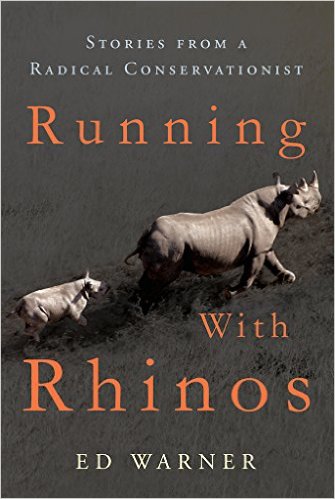I'm traveling to all 54 African countries from 2013-2018 and I’m spending about 5 weeks in each country, so Running with Rhinos interested me. I was hoping to learn amazing rhino facts that few know about and get some insight into the rhino ecosystem. However, I was disappointed.
 The author, Ed Warner, promises that this book will be different than other rhino books because it’s “written by a long-term, non-professional volunteer . . . who has worked with veterinarians and biologists who care for rhinos in Africa. Few if any laymen like me have been invited to do what amounts to some of the most dangerous volunteer fieldwork around.”
The author, Ed Warner, promises that this book will be different than other rhino books because it’s “written by a long-term, non-professional volunteer . . . who has worked with veterinarians and biologists who care for rhinos in Africa. Few if any laymen like me have been invited to do what amounts to some of the most dangerous volunteer fieldwork around.”
Yes, it’s a different perspective, but a less interesting one than the alternative. Wouldn’t you rather hear from a full-time lifelong rhino expert instead of a “non-professional volunteer” who helps out a couple of weeks per year?
First the good news
I did learn a few things. For example, I learned that most rhinos live in Southern Africa: “The black rhino is solitary unless with a calf. Fewer than 5,000 rhinos remain in the wilds of Africa, with the largest populations in South Africa, Namibia, and Zimbabwe.”
And now the bad news
Running With Rhinos is filled with macho man stuff. Warner seems to think of himself as a John Wayne cowboy in the African bush. He’s the kind of guy who would get his leg chomped on by a crocodile and he’d shrug it off as “just a flesh wound.”
He loves to exaggerate, like when he wrote in the caption of a photo showing a rocky terrain, “Yes, folks, that’s what they call a ‘road’ in Marienfluess, Namibia.”
I’ve driven all over Namibia (and over 150,000 km in Africa) and the “road” he shows in the foreground photo isn’t a road at all (not even a crappy one). It’s a completely impassible hill of rocks. In the background of the photo, you can make out a smoother, sand-filled passage, where the truck came in. But Warner wants you to believe that they drove across that rock-filled nightmare.
I’m sure Warner did plenty of rigorous off-roading, but he prefers to spin a tall tale of his daring driving experience.
Another example is when he claimed, “There was no petrol in the whole country that year.” That’s simply an exaggeration. Yes, Zimbabwe experienced a severe petrol shortage that perhaps made people feel that there was no petrol, but there was petrol because the black market works.
He indulges in making humble brags. For example, there's the story of when he captures a snake. It’s an impressive feat, but the way he retells it is that annoying ah-shucks style. The black Africans were awed with his snake capturing skills and he shrugs it off like, “That’s just what I do.”
At other times, he comes across as the stereotypical arrogant ugly American who doesn’t adapt to the local customs, even when he knows what they are. For example, he “met three different ministers or cabinet members and the head of National Parks. I’m sure my calling everyone by first names is dead wrong in this very socially conscious society. Trouble is, I have my own set of rules. First names first. it’s always been that way with me and always will. My friends can only hope I never run into the president or the pope. (I’ve since run into four presidents and two prime ministers. I’ve called all of them by their first names. ‘Hi Bill [Clinton], I’m Ed, and this is Jackie.’”
(Notice the name drop there, another humblebrag.)
Running With Rhinos will make statements without backing it up with more detail. I would have loved it if Warner could explain why he thinks that the US “regulatory system of trophy hunting cannot properly manage deer populations. White-tailed deer are also severely hindering the regrowth of US Midwest and eastern forests, which are in crisis due to the old-growth reaching the end of its life cycle.”
It's an important and profound statement, but he just lets it die there instead of developing it. I realize it's a book about rhinos, but a few extra sentences would have shed some light on the obscure subject.
Similarly, he calls the white-tailed deer and the Canada geese “pests,” but does little to explain why they’re “pests.” Rhinos are certainly pests for many African farms. Should we kill those too? How do we decide when an animal is a "pest"? He doesn't
address that crucial issue.
There’s a Q&A at the end of the ebook, where he also throws out a tantalizing thought that he fails to develop: “Westerners have a lot to learn from African people and the wildlife with which they live.”
Really?
Great. Like what?
He doesn’t say.
From what I know, Africans are simply copying Westerners ever since they acquired Western firearms: driving all their wildlife to extinction. It’s Western organizations that are supplying much of the funding to preserve the wilderness left in Africa. If it wasn’t for Western NGOs (like the Lowveld Rhino Trust run by Dr. Susie Ellis, which Warner is giving the “net proceeds” of Running With Rhinos to), then African wildlife would be even worse off than it is.
Indeed, later in the same interview, Warner admits that: “We cannot save Africa from bad governments. Africans must evolve forms of government that work for them. Until they do, the wildlife will remain at risk.”
Exactly.
That illustrates that his previous statement about Westerners having “a lot to learn from Africans” was simply a politically correct statement with no substance to back it up.
Moreover, Running With Rhinos completely ignores the elephant in the African room: its fast-growing population. All the conservation efforts will amount to little when Africa has 2-3 billion people. He completely avoids this massive environmental issue, which is the most important issue of all. All environmental issues improve when a region depopulates.
In conclusion, Running With Rhinos is a letdown. There are promising passages, but before Warner can develop them, he changes the subject. I would have loved to hear more about the rhino ecosystem, its life cycle, its diet, and its gestation period. Instead, the words “diet” and “gestation” don’t appear in the book.
Although they shoot rhinos often with tranquilizer guns, Warner provides scant details about them. How's the dose determined? Do they sometimes accidentally kill them with an overdose? At other times do they survive the dose and run away?
This is a harsh review. I've never heard of Ed Warner or his organization before this book. I certainly commend his remarkable dedication and contribution to helping rhinos. I just dislike this book. It feels self-published, although the book cover is outstanding. Let's hope the publisher, Greenleaf, prints a better book about Africa soon.
Lastly, Warner fills the book with banal observations that makes such as, “As soon as I lay down on the ground I saw four meteors, two nearly in tandem together, streak across the sky.”
Wow.
I’ll leave you with one more of his fascinating observations, “If I stare at the stars long enough I fall asleep.”
And if you stare at this book long enough, you’ll also fall asleep too.
VERDICT: 2 out of 10 stars.




